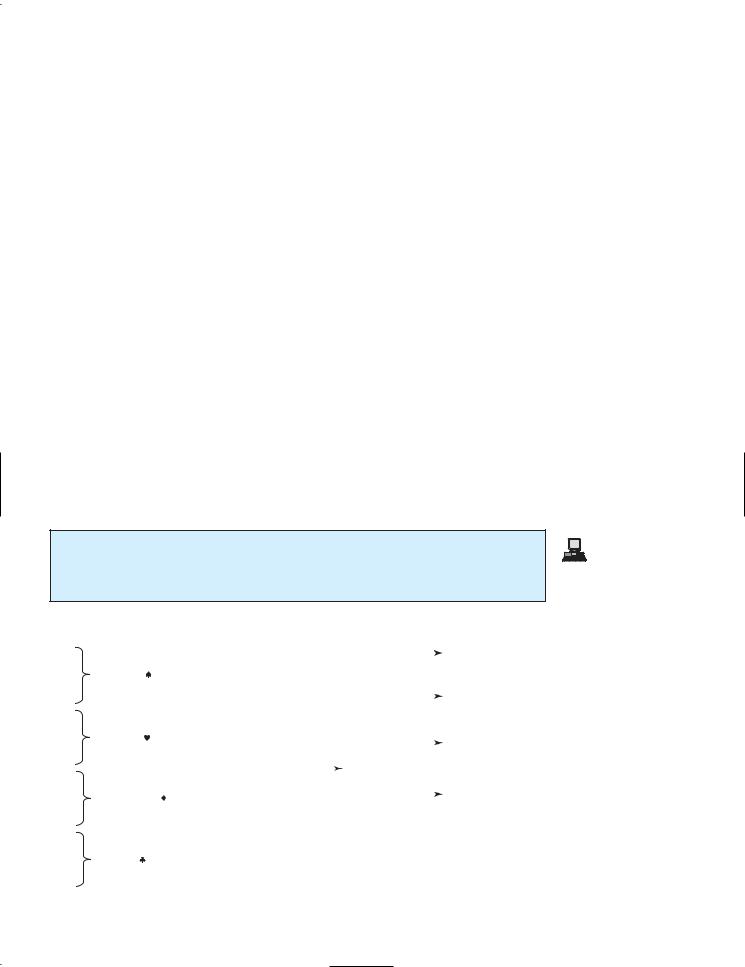
- •CONTENTS
- •1.1 Introduction
- •1.2 What Is a Computer?
- •1.3 Programs
- •1.4 Operating Systems
- •1.5 Java, World Wide Web, and Beyond
- •1.6 The Java Language Specification, API, JDK, and IDE
- •1.7 A Simple Java Program
- •1.8 Creating, Compiling, and Executing a Java Program
- •1.9 (GUI) Displaying Text in a Message Dialog Box
- •2.1 Introduction
- •2.2 Writing Simple Programs
- •2.3 Reading Input from the Console
- •2.4 Identifiers
- •2.5 Variables
- •2.7 Named Constants
- •2.8 Numeric Data Types and Operations
- •2.9 Problem: Displaying the Current Time
- •2.10 Shorthand Operators
- •2.11 Numeric Type Conversions
- •2.12 Problem: Computing Loan Payments
- •2.13 Character Data Type and Operations
- •2.14 Problem: Counting Monetary Units
- •2.15 The String Type
- •2.16 Programming Style and Documentation
- •2.17 Programming Errors
- •2.18 (GUI) Getting Input from Input Dialogs
- •3.1 Introduction
- •3.2 boolean Data Type
- •3.3 Problem: A Simple Math Learning Tool
- •3.4 if Statements
- •3.5 Problem: Guessing Birthdays
- •3.6 Two-Way if Statements
- •3.7 Nested if Statements
- •3.8 Common Errors in Selection Statements
- •3.9 Problem: An Improved Math Learning Tool
- •3.10 Problem: Computing Body Mass Index
- •3.11 Problem: Computing Taxes
- •3.12 Logical Operators
- •3.13 Problem: Determining Leap Year
- •3.14 Problem: Lottery
- •3.15 switch Statements
- •3.16 Conditional Expressions
- •3.17 Formatting Console Output
- •3.18 Operator Precedence and Associativity
- •3.19 (GUI) Confirmation Dialogs
- •4.1 Introduction
- •4.2 The while Loop
- •4.3 The do-while Loop
- •4.4 The for Loop
- •4.5 Which Loop to Use?
- •4.6 Nested Loops
- •4.7 Minimizing Numeric Errors
- •4.8 Case Studies
- •4.9 Keywords break and continue
- •4.10 (GUI) Controlling a Loop with a Confirmation Dialog
- •5.1 Introduction
- •5.2 Defining a Method
- •5.3 Calling a Method
- •5.4 void Method Example
- •5.5 Passing Parameters by Values
- •5.6 Modularizing Code
- •5.7 Problem: Converting Decimals to Hexadecimals
- •5.8 Overloading Methods
- •5.9 The Scope of Variables
- •5.10 The Math Class
- •5.11 Case Study: Generating Random Characters
- •5.12 Method Abstraction and Stepwise Refinement
- •6.1 Introduction
- •6.2 Array Basics
- •6.3 Problem: Lotto Numbers
- •6.4 Problem: Deck of Cards
- •6.5 Copying Arrays
- •6.6 Passing Arrays to Methods
- •6.7 Returning an Array from a Method
- •6.8 Variable-Length Argument Lists
- •6.9 Searching Arrays
- •6.10 Sorting Arrays
- •6.11 The Arrays Class
- •7.1 Introduction
- •7.2 Two-Dimensional Array Basics
- •7.3 Processing Two-Dimensional Arrays
- •7.4 Passing Two-Dimensional Arrays to Methods
- •7.5 Problem: Grading a Multiple-Choice Test
- •7.6 Problem: Finding a Closest Pair
- •7.7 Problem: Sudoku
- •7.8 Multidimensional Arrays
- •8.1 Introduction
- •8.2 Defining Classes for Objects
- •8.3 Example: Defining Classes and Creating Objects
- •8.4 Constructing Objects Using Constructors
- •8.5 Accessing Objects via Reference Variables
- •8.6 Using Classes from the Java Library
- •8.7 Static Variables, Constants, and Methods
- •8.8 Visibility Modifiers
- •8.9 Data Field Encapsulation
- •8.10 Passing Objects to Methods
- •8.11 Array of Objects
- •9.1 Introduction
- •9.2 The String Class
- •9.3 The Character Class
- •9.4 The StringBuilder/StringBuffer Class
- •9.5 Command-Line Arguments
- •9.6 The File Class
- •9.7 File Input and Output
- •9.8 (GUI) File Dialogs
- •10.1 Introduction
- •10.2 Immutable Objects and Classes
- •10.3 The Scope of Variables
- •10.4 The this Reference
- •10.5 Class Abstraction and Encapsulation
- •10.6 Object-Oriented Thinking
- •10.7 Object Composition
- •10.8 Designing the Course Class
- •10.9 Designing a Class for Stacks
- •10.10 Designing the GuessDate Class
- •10.11 Class Design Guidelines
- •11.1 Introduction
- •11.2 Superclasses and Subclasses
- •11.3 Using the super Keyword
- •11.4 Overriding Methods
- •11.5 Overriding vs. Overloading
- •11.6 The Object Class and Its toString() Method
- •11.7 Polymorphism
- •11.8 Dynamic Binding
- •11.9 Casting Objects and the instanceof Operator
- •11.11 The ArrayList Class
- •11.12 A Custom Stack Class
- •11.13 The protected Data and Methods
- •11.14 Preventing Extending and Overriding
- •12.1 Introduction
- •12.2 Swing vs. AWT
- •12.3 The Java GUI API
- •12.4 Frames
- •12.5 Layout Managers
- •12.6 Using Panels as Subcontainers
- •12.7 The Color Class
- •12.8 The Font Class
- •12.9 Common Features of Swing GUI Components
- •12.10 Image Icons
- •13.1 Introduction
- •13.2 Exception-Handling Overview
- •13.3 Exception-Handling Advantages
- •13.4 Exception Types
- •13.5 More on Exception Handling
- •13.6 The finally Clause
- •13.7 When to Use Exceptions
- •13.8 Rethrowing Exceptions
- •13.9 Chained Exceptions
- •13.10 Creating Custom Exception Classes
- •14.1 Introduction
- •14.2 Abstract Classes
- •14.3 Example: Calendar and GregorianCalendar
- •14.4 Interfaces
- •14.5 Example: The Comparable Interface
- •14.6 Example: The ActionListener Interface
- •14.7 Example: The Cloneable Interface
- •14.8 Interfaces vs. Abstract Classes
- •14.9 Processing Primitive Data Type Values as Objects
- •14.10 Sorting an Array of Objects
- •14.11 Automatic Conversion between Primitive Types and Wrapper Class Types
- •14.12 The BigInteger and BigDecimal Classes
- •14.13 Case Study: The Rational Class
- •15.1 Introduction
- •15.2 Graphical Coordinate Systems
- •15.3 The Graphics Class
- •15.4 Drawing Strings, Lines, Rectangles, and Ovals
- •15.5 Case Study: The FigurePanel Class
- •15.6 Drawing Arcs
- •15.7 Drawing Polygons and Polylines
- •15.8 Centering a String Using the FontMetrics Class
- •15.9 Case Study: The MessagePanel Class
- •15.10 Case Study: The StillClock Class
- •15.11 Displaying Images
- •15.12 Case Study: The ImageViewer Class
- •16.1 Introduction
- •16.2 Event and Event Source
- •16.3 Listeners, Registrations, and Handling Events
- •16.4 Inner Classes
- •16.5 Anonymous Class Listeners
- •16.6 Alternative Ways of Defining Listener Classes
- •16.7 Problem: Loan Calculator
- •16.8 Window Events
- •16.9 Listener Interface Adapters
- •16.10 Mouse Events
- •16.11 Key Events
- •16.12 Animation Using the Timer Class
- •17.1 Introduction
- •17.2 Buttons
- •17.3 Check Boxes
- •17.4 Radio Buttons
- •17.5 Labels
- •17.6 Text Fields
- •17.7 Text Areas
- •17.8 Combo Boxes
- •17.9 Lists
- •17.10 Scroll Bars
- •17.11 Sliders
- •17.12 Creating Multiple Windows
- •18.1 Introduction
- •18.2 Developing Applets
- •18.3 The HTML File and the <applet> Tag
- •18.4 Applet Security Restrictions
- •18.5 Enabling Applets to Run as Applications
- •18.6 Applet Life-Cycle Methods
- •18.7 Passing Strings to Applets
- •18.8 Case Study: Bouncing Ball
- •18.9 Case Study: TicTacToe
- •18.10 Locating Resources Using the URL Class
- •18.11 Playing Audio in Any Java Program
- •18.12 Case Study: Multimedia Animations
- •19.1 Introduction
- •19.2 How is I/O Handled in Java?
- •19.3 Text I/O vs. Binary I/O
- •19.4 Binary I/O Classes
- •19.5 Problem: Copying Files
- •19.6 Object I/O
- •19.7 Random-Access Files
- •20.1 Introduction
- •20.2 Problem: Computing Factorials
- •20.3 Problem: Computing Fibonacci Numbers
- •20.4 Problem Solving Using Recursion
- •20.5 Recursive Helper Methods
- •20.6 Problem: Finding the Directory Size
- •20.7 Problem: Towers of Hanoi
- •20.8 Problem: Fractals
- •20.9 Problem: Eight Queens
- •20.10 Recursion vs. Iteration
- •20.11 Tail Recursion
- •APPENDIXES
- •INDEX

204 Chapter 6 Single-Dimensional Arrays
Video Note
Lotto numbers
6.3 Problem: Lotto Numbers
Each ticket for the Pick-10 lotto has 10 unique numbers ranging from 1 to 99. Suppose you buys a lot of tickets and like to have them cover all numbers from 1 to 99. Write a program that reads the ticket numbers from a file and checks whether all numbers are covered. Assume the last number in the file is 0. Suppose the file contains the numbers
80 |
3 |
87 62 |
30 90 10 |
21 46 |
27 |
||||
12 |
40 83 |
9 |
39 88 95 |
59 20 |
37 |
||||
80 |
40 87 |
67 31 90 |
11 24 |
56 77 |
|||||
11 |
48 51 |
42 8 74 1 41 |
36 53 |
||||||
52 |
82 16 |
72 19 70 |
44 56 |
29 33 |
|||||
54 |
64 99 |
14 23 22 |
94 79 |
55 2 |
|||||
60 |
86 34 |
4 |
31 63 84 |
89 7 78 |
|||||
43 |
93 97 |
45 25 38 |
28 26 |
85 49 |
|||||
47 |
65 57 |
67 73 69 |
32 71 |
24 66 |
|||||
92 |
98 96 |
77 6 75 17 |
61 58 |
13 |
|||||
35 |
81 18 |
15 5 68 91 |
50 76 |
|
|||||
0 |
|
|
|
|
|
|
|
|
|
Your program should display
The tickets cover all numbers
Suppose the file contains the numbers
11 |
48 51 |
42 8 74 1 41 |
36 53 |
||
52 |
82 16 |
72 19 70 |
44 56 |
29 33 |
|
0 |
|
|
|
|
|
Your program should display
The tickets don't cover all numbers
How do you mark a number as covered? You can create an array with 99 boolean elements. Each element in the array can be used to mark whether a number is covered. Let the array be isCovered. Initially, each element is false, as shown in Figure 6.2(a). Whenever a number is read, its corresponding element is set to true. Suppose the numbers entered are 1, 2, 3, 99, 0. When number 1 is read, isCovered[0] is set to true (see Figure 6.2(b)). When number 2 is read, isCovered[2 - 1] is set to true (see Figure 6.2(c)). When number 3 is read,
isCovered |
|
|
isCovered |
|
isCovered |
|
isCovered |
|
isCovered |
|||||||||||||
|
|
|
|
|
|
|
|
|
|
|
|
|
|
|
|
|
|
|
|
|
|
|
[0] |
false |
[0] |
|
true |
|
[0] |
|
true |
[0] |
|
true |
[0] |
|
true |
||||||||
|
|
|
|
|
|
|
|
|
|
|
|
|
|
|
|
|
|
|
|
|
|
|
[1] |
false |
[1] |
|
false |
[1] |
|
|
|
[1] |
|
true |
[1] |
|
true |
||||||||
|
|
true |
||||||||||||||||||||
|
|
|
|
|
|
|
|
|
|
|
|
|
|
|
|
|
|
|
|
|
|
|
[2] |
false |
[2] |
|
false |
[2] |
|
false |
[2] |
|
|
|
[2] |
|
true |
||||||||
|
|
|
true |
|||||||||||||||||||
|
|
|
|
|
|
|
|
|
|
|
|
|
|
|
|
|
|
|
|
|
|
|
[3] |
false |
[3] |
|
false |
[3] |
|
false |
[3] |
|
false |
[3] |
|
false |
|||||||||
|
|
|
|
|
|
|
|
|
|
|
|
|
|
|
|
|
|
|
|
|
|
|
|
. |
|
|
|
. |
|
|
|
. |
|
|
|
. |
|
|
|
. |
|
||||
|
. |
|
|
|
. |
|
|
|
. |
|
|
|
. |
|
|
|
. |
|
||||
|
. |
|
|
|
. |
|
|
|
. |
|
|
|
. |
|
|
|
. |
|
||||
|
|
|
|
|
|
|
|
|
|
|
|
|
|
|
|
|
|
|
|
|
|
|
[97] |
false |
[97] |
|
false |
[97] |
|
false |
[97] |
|
false |
[97] |
|
false |
|||||||||
|
|
|
|
|
|
|
|
|
|
|
|
|
|
|
|
|
|
|
|
|
|
|
[98] |
false |
[98] |
|
false |
[98] |
|
false |
[98] |
|
false |
[98] |
|
|
|
||||||||
|
|
|
|
true |
||||||||||||||||||
|
|
|
|
|
|
|
|
|
|
|
|
|
|
|
|
|
|
|
|
|
|
|
|
(a) |
|
|
|
|
(b) |
|
|
|
(c) |
|
|
|
(d) |
|
|
|
(e) |
||||
FIGURE 6.2 If number i appears in a Lotto ticket, isCovered[i-1] is set to true.

6.3 Problem: Lotto Numbers 205
isCovered[3 - 1] is set to true (see Figure 6.2(d)). When number 99 is read, set isCovered[98] to true (see Figure 6.2(e)).
The algorithm for the program can be described as follows:
for each number k read from the file,
mark number k as covered by setting isCovered[k – 1] true;
if every isCovered[i] is true The tickets cover all numbers
else
The tickets don't cover all numbers
The complete program is given in Listing 6.1.
LISTING 6.1 LottoNumbers.java
1 import java.util.Scanner;
2
3 public class LottoNumbers {
4 public static void main(String args[]) {
5Scanner input = new Scanner(System.in);
6 |
boolean[] isCovered = new boolean[99]; // Default is false |
create and initialize array |
7 |
|
|
8// Read each number and mark its corresponding element covered
9 |
int number = input.nextInt(); |
read number |
10 |
while (number != 0) { |
|
11 |
isCovered[number - 1] = true; |
mark number covered |
12 |
number = input.nextInt(); |
read number |
13 |
} |
|
14 |
|
|
15// Check whether all covered
16boolean allCovered = true; // Assume all covered initially
17for (int i = 0; i < 99; i++)
18if (!isCovered[i]) {
19allCovered = false; // Find one number not covered
20break;
21}
22 |
|
|
23 |
// Display result |
|
24 |
if (allCovered) |
check allCovered? |
25System.out.println("The tickets cover all numbers");
26else
27System.out.println("The tickets don't cover all numbers");
28}
29}
Suppose you have created a text file named LottoNumbers.txt that contains the input data 2 5 6 5 4 3 23 43 2 0. You can run the program using the following command:
java LottoNumbers < LottoNumbers.txt
The program can be traced as follows:
The program creates an array of 99 boolean elements and initializes each element to false (line 6). It reads the first number from the file (line 9). The program then repeats the following operations in a loop:
■If the number is not zero, set its corresponding value in array isCovered to true (line 11);
■Read the next number (line 12).

206 Chapter 6 Single-Dimensional Arrays
line |
Representative elements in array isCovered |
number |
allCovered |
|||||||
|
|
[1] |
[2] |
[3] |
[4] |
[5] |
[22] |
[42] |
|
|
6 |
false |
false |
false |
false |
false |
false |
false |
|
|
|
9 |
|
|
|
|
|
|
2 |
|
|
|
11 |
true |
|
|
|
|
|
|
|
|
|
12 |
|
|
|
|
|
|
5 |
|
|
|
11 |
|
|
|
true |
|
|
|
|
|
|
12 |
|
|
|
|
|
|
6 |
|
|
|
11 |
|
|
|
|
true |
|
|
|
|
|
12 |
|
|
|
|
|
|
5 |
|
|
|
11 |
|
|
|
true |
|
|
|
|
|
|
12 |
|
|
|
|
|
|
4 |
|
|
|
11 |
|
|
true |
|
|
|
|
|
|
|
12 |
|
|
|
|
|
|
3 |
|
|
|
11 |
|
true |
|
|
|
|
|
|
|
|
12 |
|
|
|
|
|
|
23 |
|
|
|
11 |
|
|
|
|
|
true |
|
|
|
|
12 |
|
|
|
|
|
|
43 |
|
|
|
11 |
|
|
|
|
|
|
true |
|
|
|
12 |
|
|
|
|
|
|
2 |
|
|
|
11 |
true |
|
|
|
|
|
|
|
|
|
12 |
|
|
|
|
|
|
0 |
|
|
|
16 |
|
|
|
|
|
|
|
true |
||
18(i=0) |
|
|
|
|
|
|
|
false |
||
|
|
|
|
|
|
|
|
|
|
|
When the input is 0, the input ends. The program checks whether all numbers are covered in lines 16–21 and displays the result in lines 24–27.
6.4 Problem: Deck of Cards
The problem is to write a program that picks four cards randomly from a deck of 52 cards. All the cards can be represented using an array named deck, filled with initial values 0 to 51, as follows:
int[] deck = new int[52];
// Initialize cards
for (int i = 0; i < deck.length; i++) deck[i] = i;
Card numbers 0 to 12, 13 to 25, 26 to 38, 39 to 51 represent 13 Spades, 13 Hearts, 13 Diamonds, and 13 Clubs, respectively, as shown in Figure 6.3. After shuffling the array deck, pick the first four cards from deck. cardNumber / 13 determines the suit of the card and cardNumber % 13 determines the rank of the card.
Listing 6.2 gives the solution to the problem.

6.4 Problem: Deck of Cards 207
LISTING 6.2 DeckOfCards.java
1 public class DeckOfCards {
2public static void main(String[] args) {
3 |
int[] deck = new |
int[52]; |
create array deck |
4 |
String[] suits = |
{"Spades", "Hearts", "Diamonds", "Clubs"}; |
array of strings |
5 |
String[] ranks = |
{"Ace", "2", "3", "4", "5", "6", "7", "8", "9", |
array of strings |
6 |
"10", "Jack", "Queen", "King"}; |
|
|
7 |
|
|
|
8// Initialize cards
9 |
for (int i = 0; i < deck.length; i++) |
initialize deck |
10 |
deck[i] = i; |
|
11 |
|
|
12 |
// Shuffle the cards |
|
13 |
for (int i = 0; i < deck.length; i++) { |
shuffle deck |
14// Generate an index randomly
15int index = (int)(Math.random() * deck.length);
16int temp = deck[i];
17deck[i] = deck[index];
18deck[index] = temp;
19}
20
21// Display the first four cards
22for (int i = 0; i < 4; i++) {
23 |
String |
suit |
= |
suits[deck[i] |
/ |
13]; |
suit of a card |
24 |
String |
rank |
= |
ranks[deck[i] |
% |
13]; |
rank of a card |
25System.out.println("Card number " + deck[i] + ": "
26+ rank + " of " + suit);
27}
28}
29}
Card number 6: 7 of Spades
Card number 48: 10 of Clubs
Card number 11: Queen of Spades
Card number 24: Queen of Hearts
|
|
|
deck |
|
|
deck |
|
|
|
|
|
|
||
0 |
|
|
[0] |
0 |
[0] |
6 |
|
|
|
|
|
Card number 6 is |
||
|
|
|
|
|
|
|
||||||||
. |
|
|
. |
. |
[1] |
48 |
|
|
|
|
|
7 of Spades |
||
. |
13 Spades ( |
) |
. |
. |
[2] |
11 |
|
|
|
|
|
|
||
. |
|
|
. |
. |
[3] |
24 |
|
|
|
|
|
Card number 48 is |
||
|
|
|
|
|
|
|
||||||||
12 |
|
|
[12] |
12 |
[4] |
. |
|
|
|
|
|
|||
|
|
|
|
|
|
|
10 of Clubs |
|||||||
13 |
|
|
[13] |
13 |
[5] |
. |
|
|
|
|
|
|||
|
|
|
|
|
|
|
|
|||||||
. |
|
|
. |
. |
. |
. |
|
|
|
|
|
|
||
. |
13 Hearts ( |
) |
|
|
|
|
|
|
||||||
. |
. |
. |
. |
|
|
|
|
|
Card number 11 is |
|||||
. |
|
|
|
|
|
|||||||||
|
|
. |
. |
. |
. |
|
|
|
|
|
||||
|
|
|
|
|
|
|
Queen of Spades |
|||||||
|
|
|
|
|
|
|
|
|||||||
25 |
|
|
[25] |
25 |
|
Random shuffle [25] |
. |
|
|
|
|
|
||
|
|
|
|
|
|
|
|
|
||||||
26 |
|
|
[26] |
26 |
|
|
[26] |
. |
|
|
|
|
|
|
. |
|
|
. |
. |
. |
. |
|
|
|
|
|
Card number 24 is |
||
. |
13 Diamonds ( ) |
|
|
|
|
|
||||||||
. |
. |
. |
. |
|
|
|
|
|
||||||
|
|
|
|
|
||||||||||
. |
|
|
. |
. |
. |
. |
|
|
|
|
|
Queen of Hearts |
||
|
|
|
|
|
|
|
|
|
||||||
38 |
|
|
[38] |
38 |
[38] |
. |
|
|
|
|
|
|
||
39 |
|
|
[39] |
39 |
[39] |
. |
|
|
|
|
|
|
||
. |
|
|
. |
. |
. |
. |
|
|
|
|
|
|
||
. |
13 Clubs ( ) |
|
|
|
|
|
|
|
||||||
|
. |
. |
. |
. |
|
|
|
|
|
|
||||
. |
|
|
|
|
|
|
|
|||||||
|
|
. |
. |
. |
. |
|
|
|
|
|
|
|||
51 |
|
|
|
|
|
|
|
|
||||||
|
|
[51] |
51 |
[51] |
. |
|
|
|
|
|
|
|||
|
|
|
|
|
|
|
|
|
|
|
|
|
|
|
FIGURE 6.3 52 cards are stored in an array named deck.
